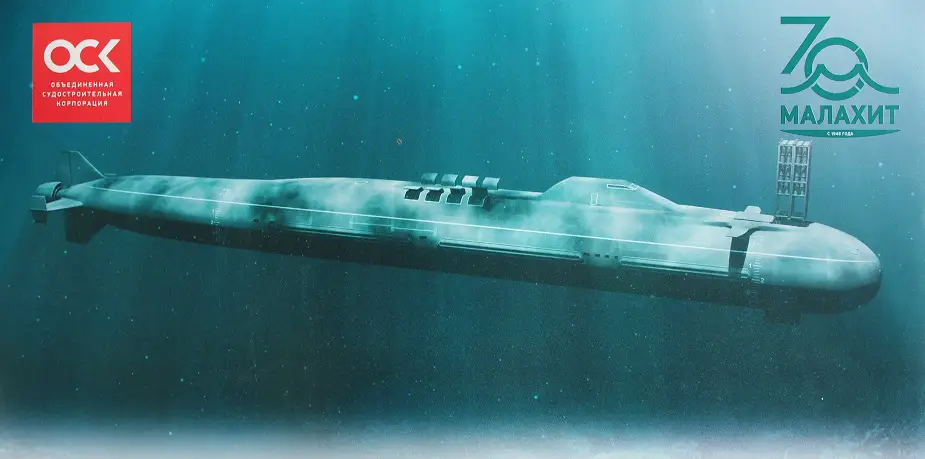Breaking news
Latest Details on Russia's Husky Fifth-Generation Submarine.
The development of the fifth-generation submarine in Russia was declared on December 16, 2014. Initially, the Malakhit bureau worked on the project as an initiative. On March 17, 2016, the code of the submarine was disclosed, Husky. On August 8, 2016, the Defense Ministry signed a contract to develop this nuclear submarine, the Izvestia newspaper reports.
 In April 2018, a concept of the USC submarine emerged on the occasion of the Malakhit bureau’s 70th anniversary. This concept features, in the nose portion, a module with Kalibr or similar missiles along with eight mounting seats for modules in the central part. On the sides are hydroacoustic system antennas. A jet propeller serves as a propulsive unit.
In April 2018, a concept of the USC submarine emerged on the occasion of the Malakhit bureau’s 70th anniversary. This concept features, in the nose portion, a module with Kalibr or similar missiles along with eight mounting seats for modules in the central part. On the sides are hydroacoustic system antennas. A jet propeller serves as a propulsive unit.
On May 22, 2018, Aleksey Rakhmanov, the head of the USC, said in an interview to Izvestia about completion of the conceptual stage in designing the fifth-generation submarine. For obvious reasons the military does not reveal details, but by now sufficient information is already available for defining the boat’s general concept.
First off, it will be built based on the modular system. The Russian Navy will get a basic underwater platform with a nuclear reactor and a propulsive system, defense equipment and command post. Provisions are made in the central part of the boat for placing various modules.
Depending on filling with them, the boat can be converted to a strategic missile or multi-role attack submarine. The modules’ main armament will be Tsirkon hypersonic anti-ship cruise missile and a new intercontinental ballistic missile. The supporting weapon systems will be Kalibr and Oniks missile systems plus various mine and torpedo armament. Such modularity will enable Russia to pass on to a single type of a nuclear submarine and significantly economize by reducing the number of combat modules and personnel strength.
Given that not all submarines are simultaneously in service, the number of modules and crews to operate them can be less than the number of boats. For example, there are eight submarines for which, however, six module packages and six crews will suffice. Obviously, at all times one or two boats are under repair or used for combat training not involving combat modules.
The reduction of crew numbers will save a great deal of wage fund of submariners, one of the highest paid categories of servicemen.
 HUSKY: Russia's Next Generation Attack Submarine. Artwork by Hisutton.com
HUSKY: Russia's Next Generation Attack Submarine. Artwork by Hisutton.com
The submarines Husky will get new torpedo tubes that will use water for launching munitions, while torpedoes themselves and other types of weapons can be launched from a depth of up to 1 km. The submarine will use a wide variety of underwater unmanned autonomous vehicles as well unmanned flying vehicles. The submarine’s noise absorbing rubberized coating will be replaced with a multiple layer of composite materials. Made from those will be hulk coatings, nose and aft rudders, stabilizers, superstructure enclosure, propellers, and shaft lines. The use of titanium alloys is also very likely, testifying to which is the possible diving depth of the submarine (up to 1 km) and its service life.
The chief asset of the submarine, its stealth, is at least twice that of the existing analogues. The noise level will be at the level of the world’s oceans. The boat’s level coinciding with that of the sea is believed to be an optimum for its stealth.
The submarine displacement will be around 12,000 tons. It will get the newest combat information control system and hydroacoustic complex and will be integrated in Russian armed forces’ single information space.
In April 2018, a concept of the USC submarine emerged in the Internet on the occasion of the Malakhit bureau’s 70th anniversary. This concept features, in the nose portion, a module with Kalibr or similar missiles along with eight mounting seats for modules in the central part. On the sides are hydroacoustic system antennas. A jet propeller serves as a propulsive unit. Thus by the end of the next decade Russia may deploy a principally new submarine that outperforms all the foreign counterparts, says the Izvestia newspaper.
© Copyright 2018 TASS. All rights reserved. This material may not be published, broadcast, rewritten or redistributed.



























